This post is part of our ongoing series about the Inflation Reduction Act. For more information, see our previous posts: Funding Our Energy Transition; Get Ready Today; Heat Pumps; Weatherization; and Appliances.
The Inflation Reduction Act (IRA) is the largest piece of climate legislation in US history. It has the potential to have enormous impacts on energy costs, pollution, and climate change. The federal government will be making huge investments into energy efficiency projects and programs. There will also be energy efficiency funding available from the Minnesota state government. One goal of these programs is to help everyone make their homes energy efficient.
Making a home energy efficient is a complex multi-step process. This post is about assessing windows and doors. Note: External doors can cause significant heat loss, but we also often see heat loss in doors leading to garages or porches. Check all doors leading to non-heated areas.

Windows and doors are often a weak energy link in homes. Drafts and condensation or frost around windows and doors often lead people to assume they need new windows. While old, inefficient windows and doors can be a factor, the issues are actually often caused by air leaks surrounding them. This is why we say “assessing” instead of replacing. New windows and doors can be expensive and sometimes unnecessary. There are often cheaper and easier solutions to consider first. We will review some simple things you can check on your own, and then explain the full assessment an auditor can provide. If you find that new windows and doors are needed after an assessment, the IRA has funds to help you.
Basic Check
There are some things anyone can check to learn more about the condition of their windows and doors. Simple adjustments to these items can improve energy efficiency.
- Check the hardware, like hinges and locks, for wear or loose screws.
- Examine window and door trim to see if caulk needs to be replaced (or added).
- Look for worn-out weatherstripping that needs replacement; this is usually installed where two moving parts meet, like the bottom of the window or around the frame of the door. Doors often have thresholds and/or sweeps installed along the bottom; take extra time to check for wear and tear there. If there is no threshold/sweep installed, installing one is a simple upgrade to improve efficiency. When checking the threshold/sweep, look to see if it is adjustable. Many thresholds and sweeps can be raised or lowered with a screwdriver to make a better seal. If you don’t immediately see the screws, they may be under plastic caps.
Example 1
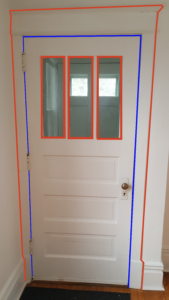
Check for:
-Loose screws or hardware issues
-Worn caulk or other sealant in red areas
-Worn weatherstripping in blue areas
-Worn/missing sweep on bottom of door
Example 2
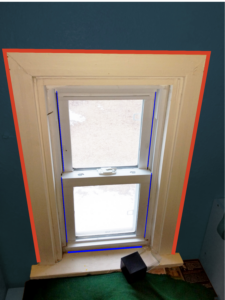
Check for:
-Wear on lock
-Worn weatherstripping in blue areas
-Worn caulk or other sealant in red areas
Example 3
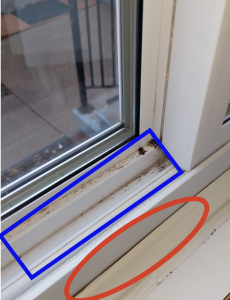
This closeup shows a gap where you could replace some sealant (red circle). Some weatherstripping might be useful in the area within the blue square.
These simple checks and fixes will help improve your home’s efficiency, but they will not give you a complete picture of the quality and condition of your windows and doors.
Full Professional Assessment
An energy audit is an in-depth assessment of your home’s efficiency. One of the most important tools of an energy audit is the infrared camera. With these images, an auditor can diagnose issues that are not usually visible.
Here is an example of an infrared image. These images are color-coded. The warmest parts of the image are shown in reds and yellows, and the coldest parts are shown in blue. At the bottom of each image, there is a color gradient showing the temperatures measured by the camera. In the upper left corner, there is a temperature; that is the reading of the temperature at the crosshair, right in the center of the image.
Below we see infrared images of the same door and windows we looked at above. Let’s take a look and see if the informal check caught the biggest sources of heat loss.
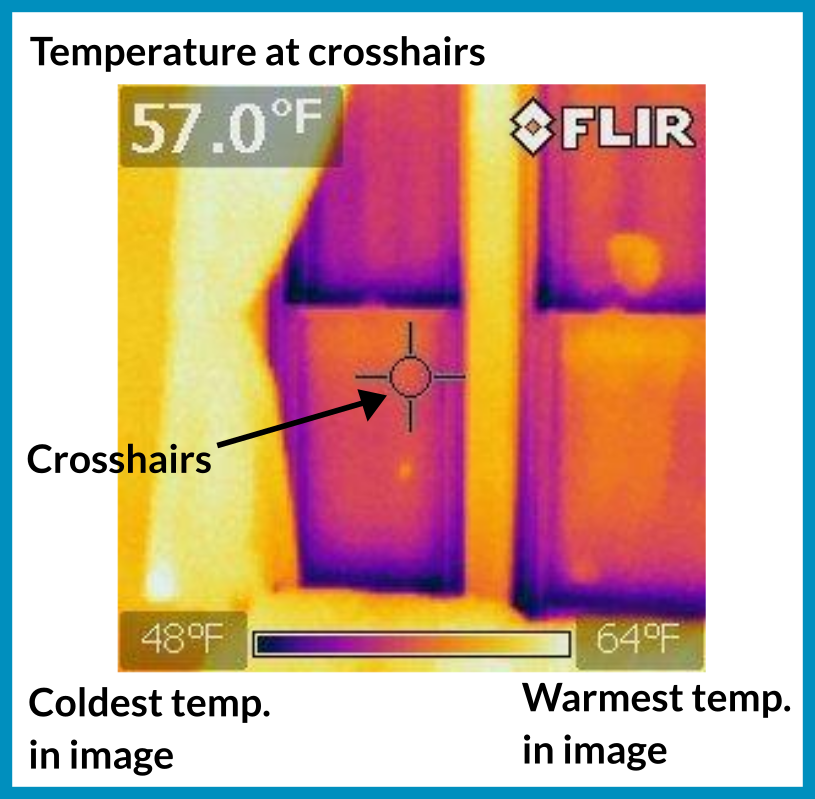
Example 1
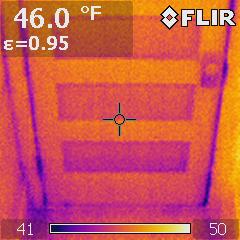
The informal check would catch most of the heat loss. The largest source of heat loss is shown with the dark blue lines, which could be improved with weatherstripping. Our auditor also noticed this is an old, under-insulated door. The three rectangles are colder than the rest of the door. The crosshair is measuring the temperature of the door at 46 degrees Fahrenheit. An insulated door would likely be in the 60s. This might be a case where installing a newer door could be worth the cost.
Example 2
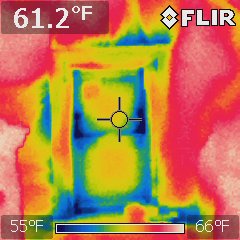
The informal check might lead to the use of rope caulk to help slow air infiltration inside the window. What our auditor noticed is the blue areas around the window, showing air infiltration around the trim. When the windows were put in, the installers likely didn’t seal or insulate that space. Caulking around the trim would help. For a more complete fix, you could try to remove the trim and use window foam to air seal the gap around the window.
Example 3
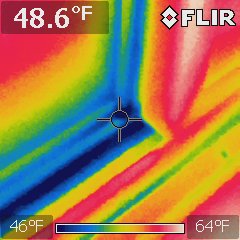
The informal check showed that weatherstripping and caulking might be helpful. The infrared image confirms that, and it also shows that there is significant heat loss occurring where the glass meets the vinyl/wood around the windowpane. Our expert auditor suggested a temporary fix of installing window kits or using rope caulk to seal this space. This is a case where the informal check might do the trick, but with an auditor’s help we know exactly which areas to target.
In each of these cases, the infrared camera shows useful information that isn’t usually visible. These are some examples of how a professional audit can reveal information beyond what is visible with an informal check. But it isn’t just the camera that provides this information. Possibly the most valuable part of an energy audit is the expertise of the auditor. Our auditors have looked at far more windows and doors than the average person! That experience is invaluable for spotting issues and giving advice.
Using the IRA
Whether you’re getting your first energy audit or gearing up for a full replacement of your windows, there is funding available to help you along the way. Let’s review some of the programs currently in action to support home energy efficiency.
Window and Door Replacement
If you’re ready to completely replace your windows and doors, there is IRA funding available under the Energy Efficient Home Improvement Credit. You can claim a non-refundable tax credit up to $600 for new windows and up to $500 for new doors. The credit is limited to $250 per door. Applicable doors and windows purchased should meet Energy Star requirements.
Whole Home Energy Efficiency
The Homeowner Managing Energy Savings (HOMES) Program is another way to improve or replace your current windows and doors. HOMES is a rebate program under the IRA that provides funding to perform whole home energy efficiency improvements. The project must increase the overall energy efficiency of your home by at least 20%, and you can earn different amounts up to $8,000 based on how much energy you save. For instance, if you find that replacing your old windows would help contribute to an overall energy saving in the home, you can earn a rebate. This would be a part of a larger energy efficiency package for the home. An energy auditor can help you with this process.
Weatherization
If your assessment finds that air sealing around your windows and doors is the best option, you can potentially claim a rebate under the Home Electrification and Appliance Rebate (HEAR) Program. You can expect up to $1,600 for air sealing measures under this IRA rebate program. IRA rebates will be managed by states, and they aren’t available yet. The good news is that the Minnesota state government is already working hard to prepare for IRA funding, so we can make the most of it once it becomes available.
Energy Audits
As always, the best place to start is by getting an energy audit. The Inflation Reduction Act allows homeowners to receive a tax credit of up to $150 for a home energy audit. Starting in 2024, the requirements for this tax credit will get more complicated; if you’re considering a home energy audit, now is a great time to take advantage of this program! Start your home energy efficiency journey with us.